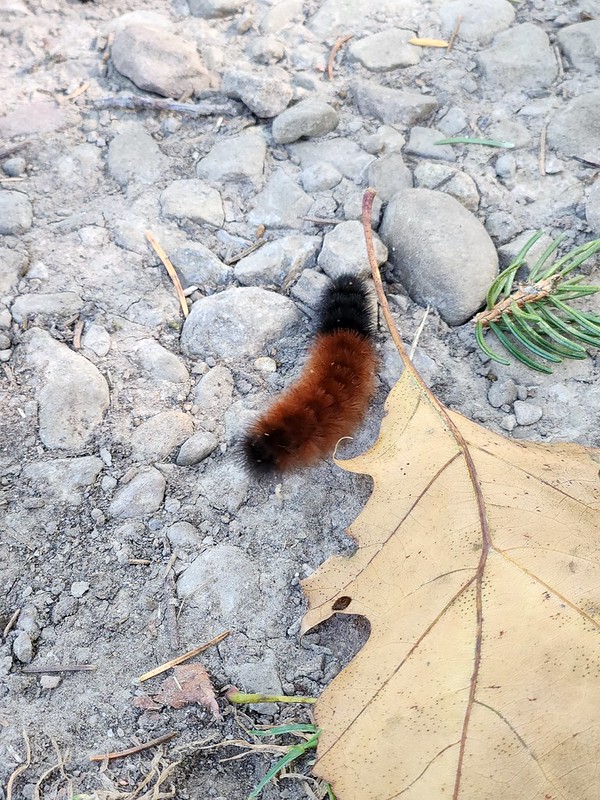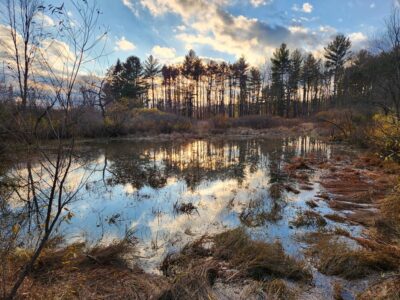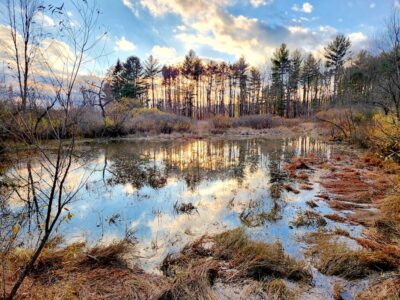Woolly bear caterpillar right in season

Woolly bear caterpillars are seen more in the spring and fall when they are travelling.
Throughout history, we have taken cues from nature to predict the weather, temperature, and seasonal changes. That might be anything from observing the sky to see how the changing clouds can indicate incoming weather to using a groundhog to predict how many more weeks of winter are on the way. Some of our cues and clues are based more in direct observation and data collection, while others seem to be born of a folk tale. However, even the folk tales sometimes have an undercurrent or grain of truth going with them. After all, they came from somewhere.
Groundhog Day is a fairly well-known holiday in the northeast. I even remember celebrating it in school. The story goes that when Punxsatawney Phil, a groundhog with its own fanbase, emerges each Feb. 2, his actions will predict whether we have six more weeks of winter. Either he sees his shadow and returns to his hole, indicating a longer winter, or he doesn’t and spring will be on its way soon.
This event is far from the only story, superstition or saying predicting something natural. Growing up, I was told the leaves would flip upside down when a storm was incoming. This is more likely due to changing wind directions, but it’s not exactly the topic of an abundance of scientific study.
You may also have heard the saying “Red sky at night, sailor’s delight. Red sky in the morning, sailors take warning.” This is potentially due to low and high pressure systems moving through which affect the abundance of particles in the atmosphere and in turn determines which color wavelengths shine through.
Now that we are well into October, we have another animal showing up that is said to predict the seasons ahead. Woolly bears are a fuzzy, black and reddish-brown caterpillar found across North America, and they have their own lore.
Woolly bear caterpillars, also known as woolly worms, are prevalent, especially in the eastern US, and become a much more consistent sighting in the fall months as the caterpillars move around more in preparation for winter.
They spend their summers consuming as much food as physically possible. The diet consists of plant leaves, but they are generalists. Although they prefer low-growing leafy plants like lamb’s quarter, violets, dandelions, and other native plants, when push comes to shove they are able to eat grasses and climb up higher to munch on tree leaves.
In the fall, their food sources dwindle and they start looking for a place to hunker down. Woolly bears get their name partially because they also hibernate through the winter, like a Black Bear. Caterpillars are a type of larva, the first stage of a butterfly’s or moth’s life cycle after hatching from their egg. They will eventually pupate, form a cocoon or chrysalis depending on the species, and emerge in their adult, winged form. Woolly bears will remain as a larva throughout the winter, and wait until the following spring to make a cocoon and turn into their adult form, the Isabella Tiger Moth.
In order to survive the winter in the caterpillar stage, they need to leave their usual food sources behind and travel to find a safe space to stay for a few months. If you have a leaf pile, or some decaying wood around your home, woolly bear caterpillars and other insects might be using it for a safe space to overwinter. Leaving these spaces in our yards can help more of them survive. Wooly bears will tuck themselves under logs, leaves, rocks, or other sheltered spaces where they can be out of sight of predators.
When the temperatures drop, woolly bears produce a glycerin and other cryoprotectants that prevents the cells from breaking down and rupturing as the caterpillar’s body freezes through. Its heart stops beating and other body functions cease during this time as well. From the outside, it looks as if it is dead. However, when it warms back up next spring, the caterpillar will unthaw and begin another journey to find a place to spin their cocoon. So, if you find a woolly bear over the winter, don’t assume it is dead! Put it back where you found it under a log or leaves so it can remain there until next spring.
There are several types of woolly bears, but the one we usually see around western NY is the banded woolly bear. This caterpillar has thirteen body segments. The segments on either end are black and the middle segments are a rusty brown, but the exact number of rusty brown versus black segments can vary between individuals.
This variation in color is said to predict how intense the coming winter will be. The wider the reddish-brown band is, the worse the winter weather, and the shorter that middle band is, then the milder the winter.
So how accurate is this fuzzy caterpillar at actually predicting the upcoming winter? Well, I don’t know that anyone has a hundred percent proven answer for you, but a few have started to see for themselves.
In the 1940s, the curator of insects at the American Museum of Nature History embarked up to Bear Mountain State Park. Over the course of several years, he and some friends would collect caterpillars and measure the number of rusty red segments on the caterpillars. It seemed to align with the winters. However, he acknowledged that the size of the study was too small to prove anything, and it was just as much a fun endeavour as any real scientific process.
Similar to the Phil the groundhog, woolly bears have their own festivals, the largest in North Carolina and Ohio, each year. In these festivals, people catch and measure the bands on hundreds of caterpillars. A few others have studied what actually causes the sizes of the bands, and determined it might be a prediction of the length of winter, just of the previous year not the upcoming one.
In all honesty, the answer to the woolly bear question is going to be up to you and what you choose to believe. As with many superstitions, folk tales, and old adages, there isn’t a ton of scientific backing either way, but maybe with some observation and data collection of your own you can come to your own conclusion.
Audubon Community Nature Center builds and nurtures connections between people and nature. ACNC is located just east of Route 62 between Warren and Jamestown. The trails are open from dawn to dusk and birds of prey can be viewed anytime the trails are open. The Nature Center is open from 10 a.m. until 4:30 p.m. daily except Sunday when it opens at 1 p.m. More information can be found online at auduboncnc.org or by calling (716) 569-2345.




